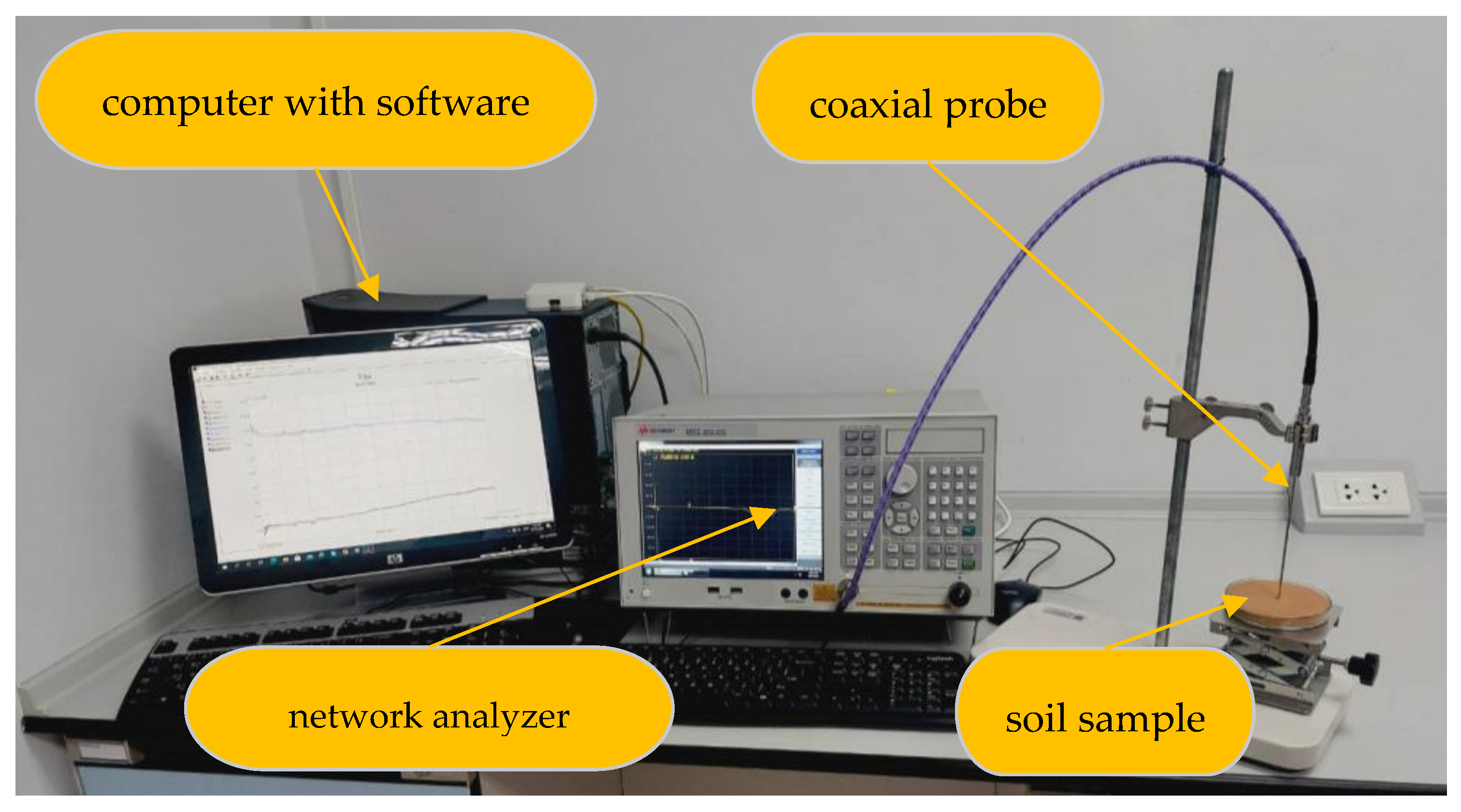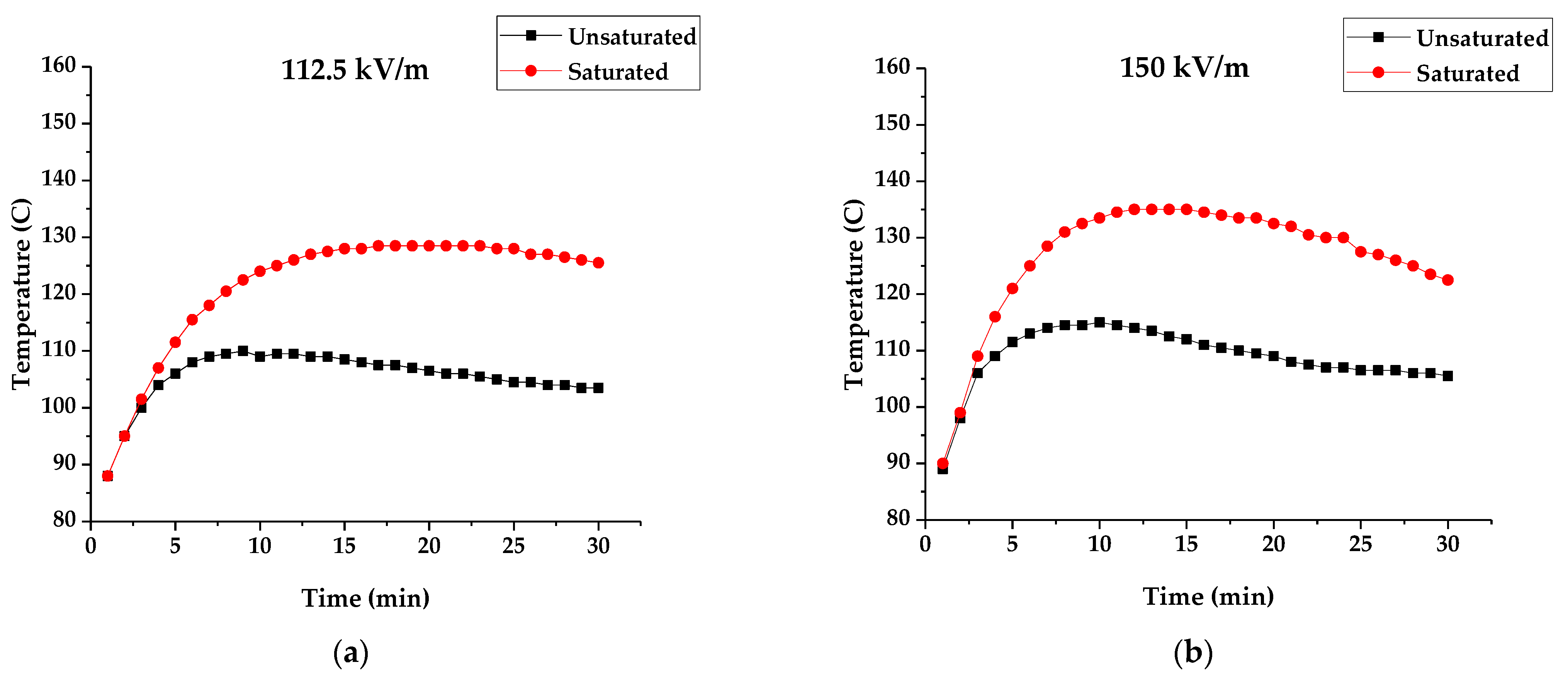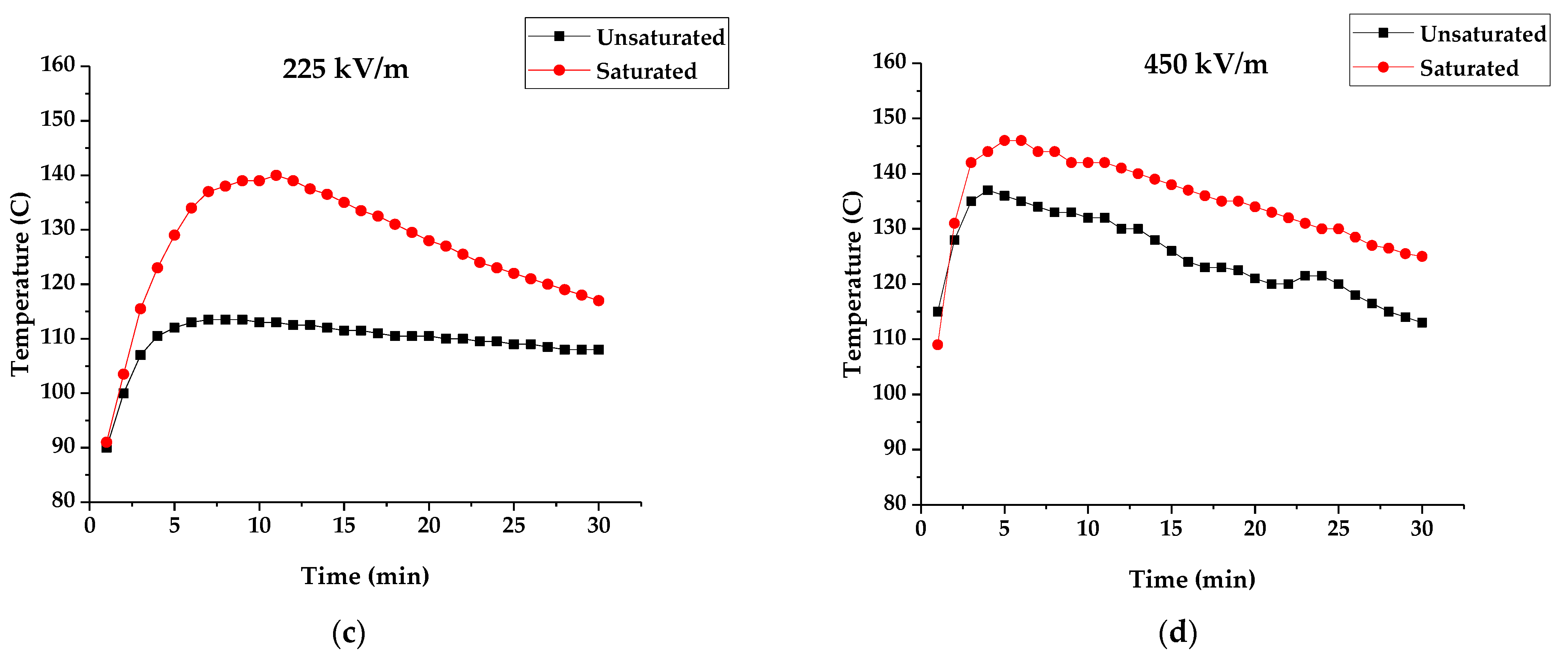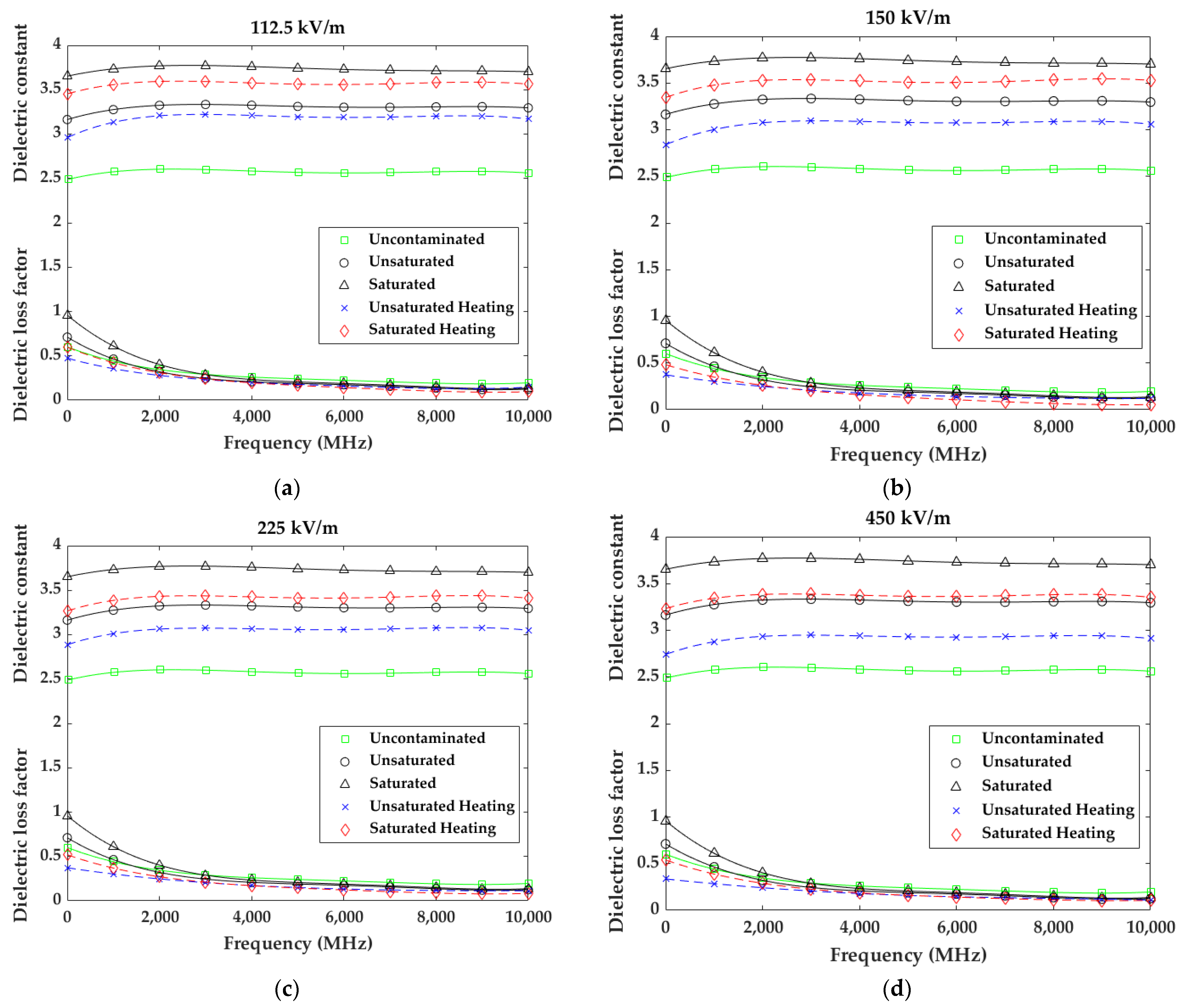Measurement of Dielectric Properties in Soil Contaminated by Biodiesel-Diesel Blends Based on Radio Frequency Heating
Abstract
:1. Introduction
2. Materials and Methods
2.1. Soil Sample Preparation
2.2. Experimental Setup for RF Heating System
2.3. Measurement of Dielectric Properties
2.4. Statistical Analysis
3. Results and Discussion
3.1. Investigation of Relative Electric Field Intensity and Temperature on Heating System
3.2. Result of Dielectric Properties
4. Conclusions
Author Contributions
Funding
Institutional Review Board Statement
Informed Consent Statement
Data Availability Statement
Acknowledgments
Conflicts of Interest
References
- Hawrot-Paw, M.; Koniuszy, A.; Zając, G.; Szyszlak-Bargłowicz, J. Ecotoxicity of soil contaminated with diesel fuel and biodiesel. Sci. Rep. 2020, 10, 16436. [Google Scholar] [CrossRef] [PubMed]
- Chun, Y.; Du, J.; Zhou, D.; Liu, Z.; Liang, T.; Qin, J.; Su, J. Effect of thermal treatment on the expansion characteristics of the diesel-contaminated soil and its mechanism. Bull. Eng. Geol. Environ. 2022, 81, 159. [Google Scholar] [CrossRef]
- Shang, Z.; Xu, P.; Yue, H.; Feng, D.; Zhu, T.; Li, X. Remediation of diesel-contaminated soil by alkoxyethanol aqueous two-phase system. Environ. Sci. Pollut. Res. 2022, 29, 25810–25823. [Google Scholar] [CrossRef] [PubMed]
- Wohlmann, W.; Neves, V.M.; Heidrich, M.G.; Silva, J.S.; Costa, A.B.; Paniz, J.N.G.; Dressler, V.L. Development of an electrothermal vaporizer for direct mercury determination in soil by inductively-coupled plasma mass spectrometry. Spectrochim. Acta Part B At. Spectrosc. 2018, 149, 222–228. [Google Scholar] [CrossRef]
- Vergnano, A.; Godio, A.; Raffa, C.M.; Chiampo, F.; Bosco, F.; Ruffino, B. Time-Domain Reflectometry (TDR) Monitoring at a Lab Scale of Aerobic Biological Processes in a Soil Contaminated by Diesel Oil. Appl. Sci. 2019, 9, 5487. [Google Scholar] [CrossRef] [Green Version]
- Vergnano, A.; Godio, A.; Bosco, F.; Raffa, C.; Ruffino, B.; Chiampo, F. Geophysical Monitoring at Laboratory Scale of Aerobic Degradation of Diesel Oil. Int. J. Adv. Sci. Eng. 2020, 6, 1413–1418. [Google Scholar] [CrossRef]
- González-Teruel, J.D.; Jones, S.B.; Soto-Valles, F.; Torres-Sánchez, R.; Lebron, I.; Friedman, S.P.; Robinson, D.A. Dielectric Spectroscopy and Application of Mixing Models Describing Dielectric Dispersion in Clay Minerals and Clayey Soils. Sensors 2020, 20, 6678. [Google Scholar] [CrossRef]
- Raffa, C.M.; Vergnano, A.; Chiampo, F.; Godio, A. Integrated use of chemical and geophysical monitoring to study the diesel oil biodegradation in microcosms with different operative conditions. J. Environ. Health Sci. Eng. 2021, 19, 1263–1276. [Google Scholar] [CrossRef]
- Dahim, M.; Abuaddous, M.; Ismail, R.; Al-Mattarneh, H.; Jaradat, A. Using a Dielectric Capacitance Cell to Determine the Dielectric Properties of Pure Sand Artificially Contaminated with Pb, Cd, Fe, and Zn. Appl. Environ. Soil Sci. 2020, 2020, 8838054. [Google Scholar] [CrossRef]
- Liu, Z.; Liu, S.; Cai, Y.; Fang, W. Electrical resistivity characteristics of diesel oil-contaminated kaolin clay and a resistivity-based detection method. Environ. Sci. Pollut. Res. 2015, 22, 8216–8223. [Google Scholar] [CrossRef]
- Cataldo, A.; Farhat, I.; Farrugia, L.; Persico, R.; Schiavoni, R.A. Method for Extracting Debye Parameters as a Tool for Monitoring Watered and Contaminated Soils. Appl. Environ. Soil Sci. 2022, 22, 7805. [Google Scholar] [CrossRef] [PubMed]
- Abdelgwad, A.H.; Said, T.M. Design of ground penetrating radar antenna for detecting soil contamination at L-band frequencies. J. Microw. Optoelectron. Electromagn. Appl. 2017, 16, 853–866. [Google Scholar] [CrossRef]
- Ghazali, M.D.; Zainon, O.; Idris, K.M.; Zainon, S.N.A.; Karim, M.N.A.; Anshah, S.A.; Talib, N.F.A. The Assessment of Relative Permittivity on Diesel Vapour in the Moisture Content of Terap Red Soil by Ground Penetrating Radar. Air Soil Water Res. 2020, 13, 1–11. [Google Scholar] [CrossRef]
- Godio, A. Open ended-coaxial cable measurements of saturated sandy soils. Am. J. Environ. Sci. 2007, 3, 175–182. [Google Scholar] [CrossRef]
- Abdelgwad, A.H.; Said, T.M. Measured dielectric permittivity of contaminated sandy soil at microwave frequency. J. Microw. Optoelectron. Electromagn. Appl. 2016, 15, 115–122. [Google Scholar] [CrossRef] [Green Version]
- Douglas, R.K.; Nawar, S.; Alamar, M.C.; Coulon, F.; Mouazen, A.M. Almost 25 years of chromatographic and spectroscopic analytical method development for petroleum hydrocarbons analysis in soil and sediment: State-of-the-art, progress and trends. Crit. Rev. Environ. Sci. Technol. 2017, 47, 1497–1527. [Google Scholar] [CrossRef]
- Ghiri, R.E.; Kaya, E.; Entesari, K. Time-domain dielectric spectroscopy using a miniaturized contact-based UWB system. IEEE Trans. Microw. Theory Tech. 2018, 66, 5863–5872. [Google Scholar] [CrossRef]
- Falciglia, P.P.; Catalfob, A.; Finocchiaro, G.; Vagliasindi, F.G.A.; Romano, S.; Guidi, G.D. Microwave heating coupled with UV-A irradiation for PAH removal from highly contaminated marine sediments and subsequent photo-degradation of the generated vaporized organic compounds. Chem. Eng. J. 2018, 334, 172–183. [Google Scholar] [CrossRef]
- Wattana, S.; Wattana, B.; Purathanung, T. Impacts of Palm Oil-based Biofuel Utilization Promotion Policy in the Thai Transport Sector. Environ. Res. Eng. Manag. 2020, 78, 7–18. [Google Scholar] [CrossRef]
- Tongroon, M.; Saisirirat, P.; Suebwong, A.; Aunchaisri, J.; Kananont, M.; Chollacoop, N. Combustion and emission characteristics investigation of diesel-ethanol-biodiesel blended fuels in a compression-ignition engine and benefit analysis. Fuel 2019, 255, 115728. [Google Scholar] [CrossRef]
- Ozturk, S.; Kong, F.; Singh, R.K.; Kuzy, J.D.; Li, C.; Trabelsi, S. Dielectric properties, heating rate, and heating uniformity of various seasoning spices and their mixtures with radio frequency heating. J. Food Eng. 2018, 228, 128–141. [Google Scholar] [CrossRef]
- Wang, L.; Kang, J.; Zhu, C.; Zhou, Z.; Wang, S.; Huang, Z. Modeling the RF heating uniformity contributed by a rotating turntable. J. Food Eng. 2023, 339, 111289. [Google Scholar] [CrossRef]
- Bientinesi, M.; Scali, C.; Petarca, L. Radio Frequency heating for oil recovery and soil remediation. IFAC-Pap. 2015, 48, 1198–1203. [Google Scholar] [CrossRef]
- Taheri, S.; Brodie, G.; Jacob, M.V.; Antunes, E. Dielectric properties of chickpea, red and green lentil in the microwave frequency range as a function of temperature and moisture content. J. Microw. Power Electromagn. Energy 2018, 52, 198–241. [Google Scholar] [CrossRef]
- Ansari, M.A.H.; Jha, A.K.; Akhter, Z.; Akhtar, M.J. Multi-band RF planar sensor using complementary split ring resonator for testing of dielectric materials. IEEE Sens. J. 2018, 18, 6596–6606. [Google Scholar] [CrossRef]
- Guan, S.; Liu, W.; Liu, W.; Nai, C. Dielectric Properties Based Detection of Heavy Metal Contaminated Soil in the Frequency Range from 10 MHz to 1 GHz. Soil Sediment Contam. Int. J. 2018, 27, 343–356. [Google Scholar] [CrossRef]
- Schennen, S.; Wagner, N.; Gunther, T.; Igel, J. Broadband Dielectric Spectroscopy with Coaxial Transmission Line Technique-A new inversion approach. In Proceedings of the 2021 13th International Conference on Electromagnetic Wave Interaction with Water and Moist Substances (ISEMA), Christian-Albrechts-Universität zu Kiel, Kiel, Germany, 26–30 July 2021. [Google Scholar]
- Orangi, A.; Orangi, G.A.; Wang, Y.H.; Ryu, D. Experimental investigation of dry density effects on dielectric properties of soil--water mixtures with different specific surface areas. Acta Geotech. 2020, 15, 1153–1172. [Google Scholar] [CrossRef]
- Orangi, A.; Narsilio, G.A. Physical characterisation of soils recovered from the anzac battlefield. Near Surf. Geophys. 2017, 15, 85–101. [Google Scholar] [CrossRef]
- Sun, H.; Yang, X.; Xie, J.; Li, X.; Zhao, Y. Remediation of Diesel-Contaminated Aquifers Using Thermal Conductive Heating Coupled With Thermally Activated Persulfate. Water Air Soil Pollut. 2021, 232, 293. [Google Scholar] [CrossRef]
- Zivdar, Z.; Heidarzadeh, N.; Asadollahfardi, G. Remediation of diesel-contaminated soil by low-temperature thermal desorption. Int. J. Environ. Sci. Technol. 2019, 16, 6113–6124. [Google Scholar] [CrossRef]
- Falciglia, P.P.; Maddalena, R.; Mancuso, G.; Messina, V.; Vagliasindi, F.G.A. Lab-scale investigation on remediation of diesel-contaminated aquifer using microwave energy. J. Environ. Manag. 2016, 167, 196–205. [Google Scholar] [CrossRef] [PubMed] [Green Version]
- Vergnano, A.; Godio, A.; Raffa, C.M.; Chiampo, F.; Vasquez, J.A.T.; Vipiana, F. Open-ended coaxial probe measurements of complex dielectric permittivity in diesel-contaminated soil during bioremediation. Sensors 2020, 20, 6677. [Google Scholar] [CrossRef] [PubMed]
- Eldos, H.I.; Ashfaq, M.Y.; Al-Ghouti, M.A.; Kuzy, J.D.; Li, C.; Trabelsi, S. Rapid assessment of the impact of microwave heating coupled with UV-C radiation on the degradation of PAHs from contaminated soil using FTIR and multivariate analysis. Arab. J. Chem. 2020, 13, 7609–7625. [Google Scholar] [CrossRef]
- Gimžauskaitė, D.; Tamošiūnas, A.; Tučkutė, S.; Snapkauskienė, V.; Aikas, M.; Uscila, R. Treatment of diesel-contaminated soil using thermal water vapor arc plasma. Environ. Sci. Pollut. Res. 2020, 27, 43–54. [Google Scholar] [CrossRef]






| Parameter | Value |
|---|---|
| Soil (g) | 100 g |
| Particle size (mm) | 0.10–0.25 mm |
| Porosity | 0.67 |
| Volume of soil jars | 117.75 cm3 |
| Bulk density | 0.85 g/cm3 |
| Diesel fuel | 20, 80 g |
| Contaminated Soil Condition | Frequency (MHz) | None | 112.5 kV/m | 150 kV/m | 225 kV/m | 450 kV/m | |||||
|---|---|---|---|---|---|---|---|---|---|---|---|
| ε′ | ε″ | ε′ | ε″ | ε′ | ε″ | ε′ | ε″ | ε′ | ε″ | ||
| Unsaturated | 200 | 3.06 | 0.73 | 2.94 | 0.60 | 2.74 | 0.47 | 2.68 | 0.43 | 2.59 | 0.40 |
| 400 | 3.21 | 0.65 | 3.05 | 0.50 | 2.90 | 0.43 | 2.88 | 0.39 | 2.75 | 0.38 | |
| 600 | 3.27 | 0.53 | 3.13 | 0.43 | 3.00 | 0.37 | 2.98 | 0.36 | 2.85 | 0.34 | |
| 800 | 3.27 | 0.47 | 3.14 | 0.42 | 3.02 | 0.36 | 3.02 | 0.34 | 2.88 | 0.33 | |
| 1000 | 3.26 | 0.43 | 3.10 | 0.36 | 2.99 | 0.31 | 3.03 | 0.30 | 2.88 | 0.29 | |
| Saturated | 200 | 3.29 | 0.77 | 3.22 | 0.67 | 3.11 | 0.54 | 3.01 | 0.57 | 2.99 | 0.59 |
| 400 | 3.69 | 0.89 | 3.45 | 0.60 | 3.35 | 0.51 | 3.25 | 0.51 | 3.23 | 0.55 | |
| 600 | 3.80 | 0.82 | 3.54 | 0.50 | 3.45 | 0.43 | 3.35 | 0.44 | 3.32 | 0.46 | |
| 800 | 3.78 | 0.62 | 3.57 | 0.47 | 3.48 | 0.39 | 3.39 | 0.41 | 3.35 | 0.43 | |
| 1000 | 3.68 | 0.51 | 3.58 | 0.42 | 3.50 | 0.35 | 3.41 | 0.36 | 3.37 | 0.39 | |
Disclaimer/Publisher’s Note: The statements, opinions and data contained in all publications are solely those of the individual author(s) and contributor(s) and not of MDPI and/or the editor(s). MDPI and/or the editor(s) disclaim responsibility for any injury to people or property resulting from any ideas, methods, instructions or products referred to in the content. |
© 2023 by the authors. Licensee MDPI, Basel, Switzerland. This article is an open access article distributed under the terms and conditions of the Creative Commons Attribution (CC BY) license (https://creativecommons.org/licenses/by/4.0/).
Share and Cite
Yodrot, T.; Santalunai, S.; Thongsopa, C.; Thosdeekoraphat, T.; Santalunai, N. Measurement of Dielectric Properties in Soil Contaminated by Biodiesel-Diesel Blends Based on Radio Frequency Heating. Appl. Sci. 2023, 13, 1248. https://doi.org/10.3390/app13031248
Yodrot T, Santalunai S, Thongsopa C, Thosdeekoraphat T, Santalunai N. Measurement of Dielectric Properties in Soil Contaminated by Biodiesel-Diesel Blends Based on Radio Frequency Heating. Applied Sciences. 2023; 13(3):1248. https://doi.org/10.3390/app13031248
Chicago/Turabian StyleYodrot, Teerapon, Samran Santalunai, Chanchai Thongsopa, Thanaset Thosdeekoraphat, and Nuchanart Santalunai. 2023. "Measurement of Dielectric Properties in Soil Contaminated by Biodiesel-Diesel Blends Based on Radio Frequency Heating" Applied Sciences 13, no. 3: 1248. https://doi.org/10.3390/app13031248






